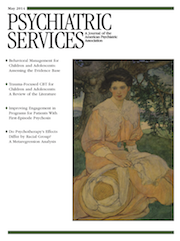Gender Differences in VA Disability Status for PTSD Over Time
Abstract
Objective
Posttraumatic stress disorder (PTSD) is the most prevalent psychiatric condition for which veterans receive service-connected disability benefits from the U.S. Department of Veterans Affairs (VA). Historically, women have been less likely than men to obtain PTSD disability benefits. The authors examined whether these gender disparities have been redressed over time and, if not, whether appropriate clinical factors account for persisting differences.
Methods
This longitudinal, observational study was based on a gender-stratified, nationally representative sample of 2,998 U.S. veterans who applied for VA disability benefits for PTSD between 1994 and 1998. The primary outcome was change in PTSD service connection over a ten-year period.
Results
Forty-two percent (95% confidence interval [CI]=38%–45%) of the women and 50% (CI=45%–55%) of the men originally denied service connection for PTSD eventually received such benefits. Only 8% (CI=7%–10%) of women and 5% (CI=4%–6%) of men lost PTSD disability status. Compared with men, women had lower unadjusted odds of gaining PTSD service connection (odds ratio [OR]=.70, CI=.55–.90) and greater unadjusted odds of losing PTSD service connection (OR=1.76, CI=1.21–2.57). Adjusting for clinical factors accounted for the gender difference in gaining PTSD service connection; adjusting for clinical factors and demographic characteristics eliminated the gender difference in loss of PTSD service connection.
Conclusions
Gender-based differences in receipt of PTSD service connection persisted in this cohort over a ten-year period but were explained by appropriate sources of variation. Further research on possible disparities in loss of PTSD disability benefits is warranted.



